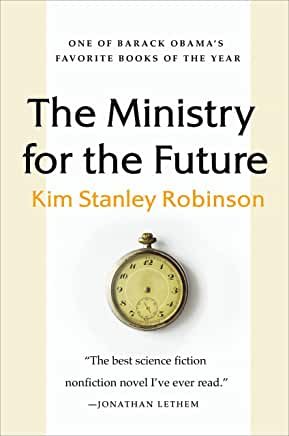Ministry for the Future
by Kim Stanley Robinson
Reviewed by Barbara Ogur
Kim Stanley Robinson starts his book, Ministry for the Future (published October 2020) through the brutal and graphically described experience of Frank, a young aid worker in an NGO in India a few years in the future, as a deadly heat crisis kills millions. If you are only slightly troubled by the anticipation of climate change, perhaps feeling somewhat sheltered by our first-world technological adaptations and our financial buffers, you may not want to read this book. Even Frank, with his privileged access to bottled water and AC (until the fuel for the generator gives out) does not fully escape. He is the only survivor in his devastated city, but deeply scarred for life. If you feel horrified by the beginning (you won’t be alone) and you decide it’s too awful to subject yourself to more, I have to say that this is a provocative book and ultimately one of the more hopeful books I have read. Humanity begins a torturous response, as the slow-moving climate catastrophe continues. It’s like watching a frog in a pot of water on the stove that is slowly being heated and wondering if it will come to its senses soon enough to jump. Robinson explores the world’s responses mainly as witnessed by the character of Mary Murphy, a quietly dedicated Irishwoman who is appointed head of a poorly funded United Nations organization, the Ministry for the Future, with the profound task of representing the needs of future generations, but with no clear authority or powers of enforcement.
And then the book ranges far and wide, exploring a number of key forces that aid and obstruct the Ministry’s efforts, including scientific and technological experimentation, the world financial system, the disparities between developed and undeveloped countries, policy initiatives like carbon exchanges and a number of others I had to look up, climate-driven migration, extreme weather events, underground violent revolutionary protest actions, and the complicated relationship between Mary and Frank.
Robinson switches perspective from chapter to chapter, and not always to a human one (one chapter might have even been from the perspective of the sun or a photon, I’m still not sure), which can be a bit confusing. Some of the subplots are fascinating, as, for example, scientists in Antarctica try to figure out if they can slow the disappearance of the glaciers. Others are disturbing, as Mary struggles to understand if violent resistance has a role in the face of an industrial sector that chooses short-term gains at the expense of fueling the looming crisis.
The characters are barely fleshed out, do not spend time in self-reflection, and have little backstory. Though Mary and Frank have a somewhat complicated human interaction that threads through, they are not really the main characters. Perhaps the main character is Humanity, represented by all of the subplots. Robinson has a clear political orientation and it’s, in the end, a cautiously hopeful one, though some of the most troubling questions are left unanswered, or maybe left for us to answer in action

